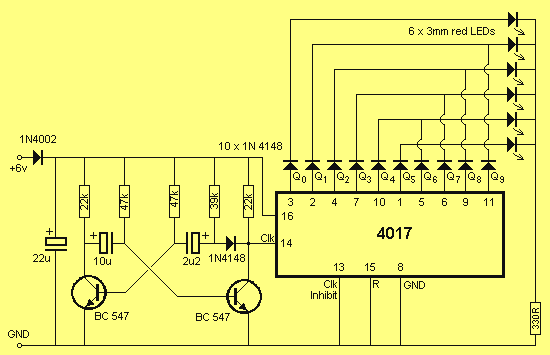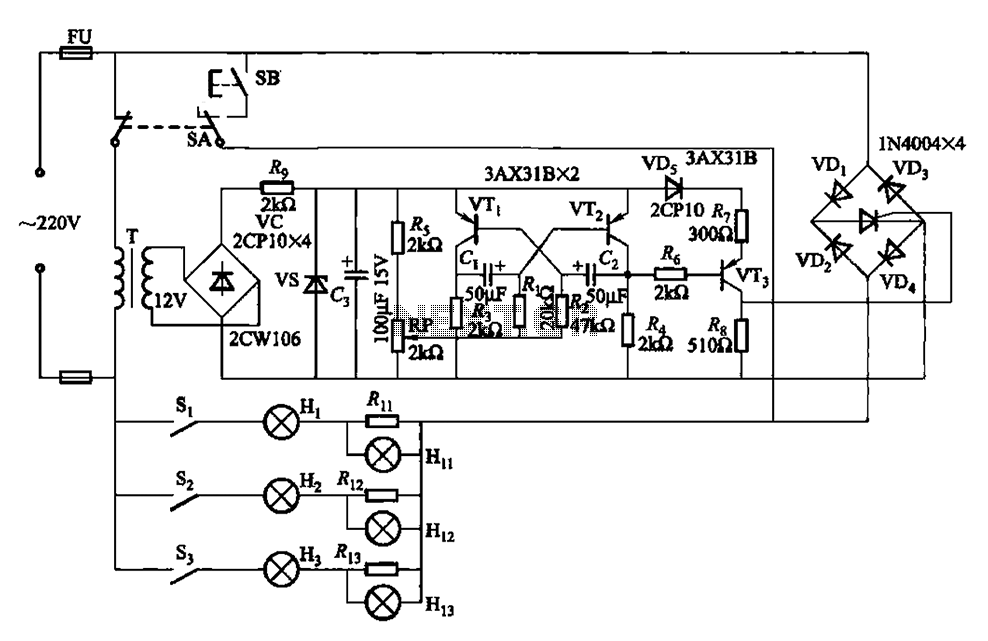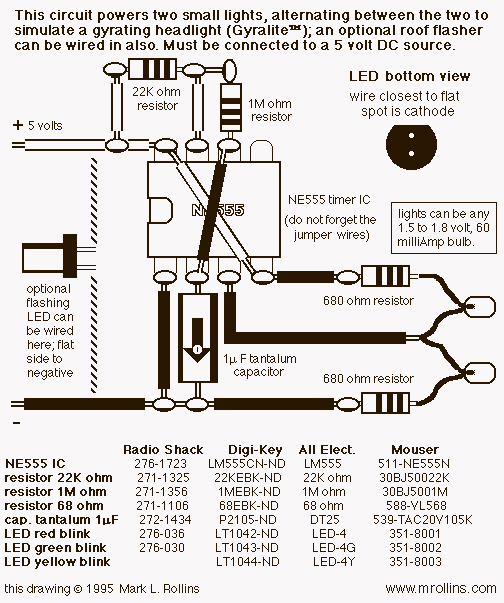
KNIGHT RIDER lights

The circuit consists of two building blocks. The first is a square wave oscillator made up of two transistors in a multivibrator arrangement and the second is a CD 4017 decade counter IC. The multivibrator contains two extra components to speed up the waveform and make it acceptable for all brands of 4017's. Unless the output has a very fast rise and fall characteristic, some 4017's fail to operate properly. They either do not work at all or jump two or three outputs, losing the scanning effect. The two speed-up components are the signal diode and 39k resistor and are essential for reliable operation. The output of the multivibrator feeds into the CLOCK INPUT of the chip. From there it goes to a complex counting circuit inside the 4017.
The circuit design features a square wave oscillator configured using a pair of NPN transistors arranged in a bistable multivibrator configuration. This arrangement generates a square wave output with a frequency determined by the values of the timing components involved, typically resistors and capacitors. The inclusion of the signal diode and a 39kΩ resistor serves to enhance the rise and fall times of the output waveform. These components mitigate issues that arise from slower transitions, which can cause unreliable operation in the CD 4017 decade counter IC.
The CD 4017 is a popular decade counter IC that counts from 0 to 9 and features ten output pins corresponding to each count. The clock input of the 4017 is sensitive to the characteristics of the incoming signal; thus, ensuring a sharp transition is critical for accurate counting. The output from the multivibrator is connected directly to the CLOCK INPUT of the CD 4017. When the multivibrator outputs a pulse, it triggers the counting sequence within the 4017.
In summary, this circuit effectively combines a multivibrator oscillator with a decade counter to create a reliable counting mechanism. The design ensures that the output waveform is optimized for the operational requirements of the CD 4017, thereby preventing potential counting errors or missed pulses that could result from slower signal transitions.The circuit consists of two building blocks. The first is a square wave oscillator made up of two transistors in a multivibrator arrangement and the second is a CD 4017 decade counter IC. The multivibrator contains two extra components to speed up the waveform and make it acceptable for all brands of 4017`s.
Unless the output has a very fast rise and fall characteristic, some 4017`s fail to operate properly. They either do not work at all or jump two or three outputs, losing the scanning effect. The two speed-up components are the signal diode and 39k resistor and are essential for reliable operation. The output of the multivibrator feeds into the CLOCK INPUT of the chip. From there is goes to a complex counting circuit inside the 4017. The circ 🔗 External reference
The circuit design features a square wave oscillator configured using a pair of NPN transistors arranged in a bistable multivibrator configuration. This arrangement generates a square wave output with a frequency determined by the values of the timing components involved, typically resistors and capacitors. The inclusion of the signal diode and a 39kΩ resistor serves to enhance the rise and fall times of the output waveform. These components mitigate issues that arise from slower transitions, which can cause unreliable operation in the CD 4017 decade counter IC.
The CD 4017 is a popular decade counter IC that counts from 0 to 9 and features ten output pins corresponding to each count. The clock input of the 4017 is sensitive to the characteristics of the incoming signal; thus, ensuring a sharp transition is critical for accurate counting. The output from the multivibrator is connected directly to the CLOCK INPUT of the CD 4017. When the multivibrator outputs a pulse, it triggers the counting sequence within the 4017.
In summary, this circuit effectively combines a multivibrator oscillator with a decade counter to create a reliable counting mechanism. The design ensures that the output waveform is optimized for the operational requirements of the CD 4017, thereby preventing potential counting errors or missed pulses that could result from slower signal transitions.The circuit consists of two building blocks. The first is a square wave oscillator made up of two transistors in a multivibrator arrangement and the second is a CD 4017 decade counter IC. The multivibrator contains two extra components to speed up the waveform and make it acceptable for all brands of 4017`s.
Unless the output has a very fast rise and fall characteristic, some 4017`s fail to operate properly. They either do not work at all or jump two or three outputs, losing the scanning effect. The two speed-up components are the signal diode and 39k resistor and are essential for reliable operation. The output of the multivibrator feeds into the CLOCK INPUT of the chip. From there is goes to a complex counting circuit inside the 4017. The circ 🔗 External reference





